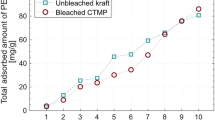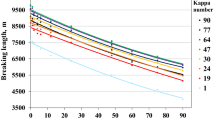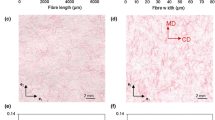Abstract
Paper is susceptible to chemical degradation through hydrolysis and oxidation, resulting in embrittlement and failure. Understanding the embrittlement process is important to ensure the preservation and longevity of historical paper-based documents. However, the complex and architectured paper microstructure is a major challenge for fully understanding this process. Two papers with different microstructures were artificially aged under hydrolytic and oxidative exposure conditions, and the consequences of ageing were studied. The fibre embrittlement, the fibre–fibre bonds deterioration, and the evolution of paper microstructure upon ageing are evaluated through macroscopic and localised mechanical tests, as well as through morphological observations at the microscopic scale. It was concluded, from the different tests in the two principal orientations of the paper, that fibre embrittlement plays a more significant role in the embrittlement process than fibre–fibre bonds deterioration. Specifically, the cellulose chain scissions led to fibre embrittlement, irrespective of the oxidative or hydrolytic nature of the chemical degradation mechanism. Furthermore, we identify a critical degree of polymerisation for cellulose (DPc ~ 750) below which the evolution of mechanical properties accelerates significantly, regardless of the type of mechanical testing performed. Fibre analysis suggests that the decline in fibre resistance results in fractures occurring under stress at weak points of the fibres, such as kinks or twists.











Similar content being viewed by others
Data availability
Data will be available upon reasonable request.
References
Ahn K, Hennniges U, Banik G, Potthast A (2012) Is cellulose degradation due to β-elimination processes a threat in mass deacidification of library books? Cellulose 19:1149–1159. https://doi.org/10.1007/s10570-012-9723-3
Ali I (2012) Study of the mechanical behavior of recycled fibers. Applications to papers and paperboards. Université de Grenoble
Arney JS, Jacobs AJ (1980) The influence of temperature on the relative contribution of oxygen-independent and oxygen-dependent processes in the total rate. Tappi J 63:75–77
Aslan M, Chinga-Carrasco G, Sørensen BF, Madsen B (2011) Strength variability of single flax fibres. J Mater Sci 46:6344–6354. https://doi.org/10.1007/s10853-011-5581-x
Bache-Wiig J, Henden PC (2010) Measurements on microtomographic images of fibrous structures: Individual fiber segmentation of 3D microtomograms of paper and wood fiber-reinforced composite materials. LAP Lambert Academic Publishing, London, United Kingdom
Barbier C, Dendievel R, Rodney D (2009) Role of friction in the mechanics of nonbonded fibrous materials. Phys Rev E 80:1–5. https://doi.org/10.1103/PhysRevE.80.016115
Barrow WJ, Sproull RC (1959) Permanence in book papers. Science 129:1075–1084
Batchelor WJ, Westerlind BS, Hägglund R, Gradin P (2006) Effect of test conditions on measured loads and displacements in zero-span testing. Tappi J 5:3–8
Battista OA, Coppick S, Howsmon JA et al (1956) Level-off degree of polymerization. Ind Eng Chem 48:333–335. https://doi.org/10.1021/ie50554a046
Bégin PL, Kaminska E (2002) Thermal accelerated ageing test method development. Restaurator 23:89–105. https://doi.org/10.1515/REST.2002.89
Bronkhorst CA (2003) Modelling paper as a two-dimensional elastic–plastic stochastic network. Int J Solids Struct 40:5441–5454. https://doi.org/10.1016/S0020-7683(03)00281-6
Carrascal IA, Fernández-Diego C, Casado JA et al (2018) Quantification of kraft paper ageing in mineral oil impregnated insulation systems through mechanical characterization. Cellulose 25:3583–3594. https://doi.org/10.1007/s10570-018-1788-1
Ciesielski PN, Wagner R, Bharadwaj VS et al (2019) Nanomechanics of cellulose deformation reveal molecular defects that facilitate natural deconstruction. PNAS 116:9825–9830. https://doi.org/10.1073/pnas.1900161116
Cox HL (1952) The elasticity and strength of paper and other fibrous materials. Br J Appl Phys 3:72–79. https://doi.org/10.1088/0508-3443/3/3/302
Deogekar S, Islam MR, Picu RC (2019) Parameters controlling the strength of stochastic fibrous materials. Int J Solids Struct 168:194–202. https://doi.org/10.1016/j.ijsolstr.2019.03.033
Deshpande VS, Ashby MF, Fleck NA (2001) Foam topology: bending versus stretching dominated architectures. Acta Mater 49:1035–1040. https://doi.org/10.1016/S1359-6454(00)00379-7
Driemeier C, Mendes FM, Oliveira MM (2012) Dynamic vapor sorption and thermoporometry to probe water in celluloses. Cellulose 19:1051–1063. https://doi.org/10.1007/s10570-012-9727-z
Dupont A-L (2003) Cellulose in lithium chloride/N, N-dimethylacetamide, optimisation of a dissolution method using paper substrates and stability of the solutions. Polymer 44:4117–4126. https://doi.org/10.1016/S0032-3861(03)00398-7
Emerson MJ, Jespersen KM, Dahl AB et al (2017) Individual fibre segmentation from 3D X-ray computed tomography for characterising the fibre orientation in unidirectional composite materials. Compos A Appl Sci Manuf 97:83–92. https://doi.org/10.1016/j.compositesa.2016.12.028
Emsley AM, Heywood RJ, Ali M, Eley CM (1997) On the kinetics of degradation of cellulose. Cellulose 4:1–5. https://doi.org/10.1023/A:1018408515574
Fayolle B, Richaud E, Colin X, Verdu J (2008) Review: degradation-induced embrittlement in semi-crystalline polymers having their amorphous phase in rubbery state. J Mater Sci 43:6999–7012. https://doi.org/10.1007/s10853-008-3005-3
Fernández-Diego C, Carrascal IA, Ortiz A et al (2021) Fracture toughness as an alternative approach to quantify the ageing of insulation paper in oil. Cellulose 28:11533–11550. https://doi.org/10.1007/s10570-021-04237-3
Ferrandin-Schoffel N, Dupont A-L, Martineau-Corcos C, Fichet O (2023) Routes to improve the strengthening of paper with aminoalkylalkoxysilanes. Cellulose 30:539–556. https://doi.org/10.1007/s10570-022-04906-x
Frase RW (1997) Preserving our documentary heritage: the case for permanent paper. IFLA J 23:140–143. https://doi.org/10.1177/034003529702300212
Gehlen MH (2010) Kinetics of autocatalytic acid hydrolysis of cellulose with crystalline and amorphous fractions. Cellulose 17:245–252. https://doi.org/10.1007/s10570-009-9385-y
Gurnagul N, Page DH (1989) The difference between dry and rewetted zero-span tensile strenght of paper. Tappi J 72:164–167
Haas DW, Hrutfiord BF, Sarkanen KV (1967) Kinetic study on the alkaline degradation of cotton hydrocellulose. J Appl Polym Sci 11:587–600. https://doi.org/10.1002/app.1967.070110408
Haslach HW Jr (2000) The moisture and rate-dependent mechanical properties of paper: a review. Mech Time-Depend Mater 4:169–210. https://doi.org/10.1023/A:1009833415827
Henniges U, Odabas N, Potthast A, Rosenau T (2016) Cellulosic fines: properties and effects. Prog Mater Sci 83:574–594. https://doi.org/10.1016/j.pmatsci.2016.07.006
Hill DJT, Le TT, Darveniza M, Saha T (1995) A study of degradation of cellulosic insulation materials in a power transformer. Part 2: tensile strength of cellulose insulation paper. Polym Degrad Stab 49:429–435. https://doi.org/10.1016/0141-3910(95)00100-Z
Hirn U, Schennach R (2015) Comprehensive analysis of individual pulp fiber bonds quantifies the mechanisms of fiber bonding in paper. Sci Rep 5:10503. https://doi.org/10.1038/srep10503
Horst TH, Smith RD, Potthast A, Hubbe MA (2020) Accelerated aging of deacidified and untreated book paper in 1967 compared with 52 years of natural aging. Restaur Int J Preserv Libr Arch Mater 41:131–152. https://doi.org/10.1515/res-2020-0006
Iribarne J, Schroeder LR (2000) The use of fundamental fiber properties to study pulp strenght. In: International paper physics seminar. Grenoble, France, p 19
Jeong M-J, Potthast A (2021) Improving the accuracy of estimating paper permanence for accelerated degradation in closed vials. Cellulose 28:4053–4068. https://doi.org/10.1007/s10570-021-03804-y
Kolar J (1997) Mechanism of autoxidative degradation of cellulose. Restaurator 18:163–176. https://doi.org/10.1515/rest.1997.18.4.163
Kontturi KS, Lee K-Y, Jones MP et al (2021) Influence of biological origin on the tensile properties of cellulose nanopapers. Cellulose 28:6619–6628. https://doi.org/10.1007/s10570-021-03935-2
Kortschot MT (1997) The role of the fibre in the structural hierarchy of paper. In: The fundametals of papermaking materials, Trans. of the XIth Fund. Res. Symp. C.F. Baker, Cambridge. p 351–399
Kurei T, Hioki Y, Kose R et al (2022) Effects of orientation and degree of polymerization on tensile properties in the cellulose sheets using hierarchical structure of wood. Cellulose 29:2885–2898. https://doi.org/10.1007/s10570-021-04160-7
I’Anson SJ, Karademir A, Sampson WW (2006) Specific contact area and the tensile strength of paper. Appita J 59:11
Leheny S, Robbins TC, Robbins CK et al (2021) Directional dependence of the mechanical properties of aged paper. Mech Mater 162:104036. https://doi.org/10.1016/j.mechmat.2021.104036
Maraghechi S, Bosco E, Suiker ASJ, Hoefnagels JPM (2023) Experimental characterisation of the local mechanical behaviour of cellulose fibres: an in-situ micro-profilometry approach. Cellulose 30:4225–4245. https://doi.org/10.1007/s10570-023-05151-6
Margutti S, Conio G, Calvini P, Pedemonte E (2001) Hydrolytic and oxidative degradation of paper. Restaurator 22:67–83. https://doi.org/10.1515/REST.2001.67
Marulier C, Dumont PJJ, Orgéas L et al (2015) 3D analysis of paper microstructures at the scale of fibres and bonds. Cellulose 22:1517–1539. https://doi.org/10.1007/s10570-015-0610-6
Neimo L (1999) Papermaking chemistry. Fapet Oy, Helsinki, Finland
Nevell TP, Zeronian SH (1985) Cellulose chemistry and its applications. Ellis Horwood, Chichester, UK
Page DH (1969) A theory for the tensile strenght of paper. Tappi J 52:674–681
Peyrega C, Jeulin D, Delisée C, Malvestio J (2009) 3D morphological modelling of a random fibrous network. Image Anal Stereol 28:129. https://doi.org/10.5566/ias.v28.p129-141
Picu CR (2021) Constitutive models for random fiber network materials: a review of current status and challenges. Mech Res Commun 114:103605. https://doi.org/10.1016/j.mechrescom.2020.103605
Piovesan C, Fabre-Francke I, Paris-Lacombe S et al (2018) Strengthening naturally and artificially aged paper using polyaminoalkylalkoxysilane copolymer networks. Cellulose 25:6071–6082. https://doi.org/10.1007/s10570-018-1955-4
Potthast A, Rosenau T, Kosma P (2006) Analysis of oxidized functionalities in cellulose. In: Klemm D (ed) Polysaccharides II. Springer, Berlin, Heidelberg, pp 1–48
Richely E, Bourmaud A, Placet V et al (2022) A critical review of the ultrastructure, mechanics and modelling of flax fibres and their defects. Prog Mater Sci 124:100851. https://doi.org/10.1016/j.pmatsci.2021.100851
Sampson WW (2009) Materials properties of paper as influenced by its fibrous architecture. Int Mater Rev 54:134–156. https://doi.org/10.1179/174328009X411154
Sampson WW (2001) The structural characterisation of fibre networks in papermaking processes—a review. In: Baker CF (ed) The science of papermaking. FRC, Manchester, pp 1205–1288
Sampson WW (2003) The statistical geometry of fractional contact area in random fibre networks. J Pulp Pap Sci 29:412–416
Sampson WW, Wang D (2020) A model for roughness statistics of heterogeneous fibrous materials. J Mater Sci 55:2636–2644. https://doi.org/10.1007/s10853-019-04193-1
Schmied FJ, Teichert C, Kappel L et al (2012) Joint strength measurements of individual fiber-fiber bonds: an atomic force microscopy based method. Rev Sci Instrum 83:073902. https://doi.org/10.1063/1.4731010
SriBala G, Vinu R (2014) Unified kinetic model for cellulose deconstruction via acid hydrolysis. Ind Eng Chem Res 53:8714–8725. https://doi.org/10.1021/ie5007905
Stephens CH, Whitmore PM, Morris HR, Bier ME (2008) Hydrolysis of the amorphous cellulose in cotton-based paper. Biomacromol 9:1093–1099. https://doi.org/10.1021/bm800049w
Strlič M, Kolar J (eds) (2005) Ageing and stabilisation of paper. National and University Library, Ljubljana
Syerko E, Comas-Cardona S, Binetruy C (2012) Models of mechanical properties/behavior of dry fibrous materials at various scales in bending and tension: a review. Compos A Appl Sci Manuf 43:1365–1388. https://doi.org/10.1016/j.compositesa.2012.03.012
Tétreault J, Bégin P, Paris-Lacombe S, Dupont A-L (2019) Modelling considerations for the degradation of cellulosic paper. Cellulose 26:2013–2033. https://doi.org/10.1007/s10570-018-2156-x
Vibert C, Fayolle B, Ricard D, Dupont A-L (2023) Decoupling hydrolysis and oxidation of cellulose in permanent paper aged under atmospheric conditions. Carbohydr Polym. https://doi.org/10.1016/j.carbpol.2023.120727
Wathén R, Batchelor W, Westerlind B, Niskanen K (2005) Analysis of strains in the fracture process zone. Nord Pulp Pap Res J 20:392–398. https://doi.org/10.3183/npprj-2005-20-04-p392-398
Wernersson ELG, Borgefors G, Borodulina S, Kulachenko A (2014) Characterisations of fibre networks in paper using micro computed tomography images. Nord Pulp Pap Res J 29:468–475. https://doi.org/10.3183/npprj-2014-29-03-p468-475
Whitmore PM, Bogaard J (1995) The effect of oxidation on the subsequent oven aging of filter paper. Restaurator 16:10–30. https://doi.org/10.1515/rest.1995.16.1.10
Wilson WK, Harvey JL, Mandel J, Worksman T (1955) Accelerated aging of record papers compared with normal aging. Tappi J 38:543–548
Young RA, Rowell RM (1986) Cellulose: structure, modification and hydrolysis. John Wiley&Sons Inc, New Jersey
Yue H, Rubalcaba JC, Cui Y et al (2019) Determination of cross-sectional area of natural plant fibres and fibre failure analysis by in situ SEM observation during microtensile tests. Cellulose 26:4693–4706. https://doi.org/10.1007/s10570-019-02428-7
Zervos S, Moropoulou A (2005) Cotton cellulose ageing in sealed vessels. Kinet Model Autocatalytic Depolym Cellul 12:485–496. https://doi.org/10.1007/s10570-005-7131-7
Zou X, Gurnagul N, Uesaka T (1993) The role of lignin in the mechanical permanence of paper—part i: effect of lignin content. J Pulp Pap Sci 19:235–239
Zou X, Gurnagul N, Uesaka T, Bouchard J (1994) Accelerated aging of papers of pure cellulose: mechanism of cellulose degradation and paper embrittlement. Polym Degrad Stab 43:393–402. https://doi.org/10.1016/0141-3910(94)90011-6
Acknowledgments
The work was financially supported by the French National Agency for Radioactive Waste Management (Andra). Hugo Mouchard is warmly thanked for his technical contribution. The financial support of the French Conservatory of Arts and Crafts (CNAM) is gratefully acknowledged.
Funding
Not applicable.
Author information
Authors and Affiliations
Contributions
CV: Conceptualization, Methodology, Investigation, Writing—Original Draft, Visualization; ALD: Resources, Writing—Review & Editing, Supervision, Project administration, Funding acquisition; JDr: Supervision, Funding acquisition; RP: Resources, Data Curation, Writing—Review & Editing; DR: Resources, Funding acquisition; BF: Writing—Review & Editing, Supervision, Project administration, Funding acquisition.
Corresponding authors
Ethics declarations
Conflict of interest
The authors have no relevant financial or non-financial interests to disclose.
Ethical approval
Not applicable.
Consent to participate
Not applicable.
Consent for publication
All the authors give their consent for the publication of this manuscript.
Additional information
Publisher's Note
Springer Nature remains neutral with regard to jurisdictional claims in published maps and institutional affiliations.
Supplementary Information
Below is the link to the electronic supplementary material.
Rights and permissions
Springer Nature or its licensor (e.g. a society or other partner) holds exclusive rights to this article under a publishing agreement with the author(s) or other rightsholder(s); author self-archiving of the accepted manuscript version of this article is solely governed by the terms of such publishing agreement and applicable law.
About this article
Cite this article
Vibert, C., Dupont, AL., Dirrenberger, J. et al. Relationship between chemical and mechanical degradation of aged paper: fibre versus fibre–fibre bonds. Cellulose 31, 1855–1873 (2024). https://doi.org/10.1007/s10570-023-05683-x
Received:
Accepted:
Published:
Issue Date:
DOI: https://doi.org/10.1007/s10570-023-05683-x




